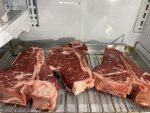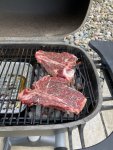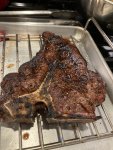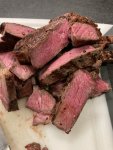John K BBQ
TVWBB All-Star
I'm not sure when reverse searing became a "thing" for steaks but I've tried it several times, and have only "nailed it" a few times. I remember watching a Good Eats episode several years ago where Alton was showing us how to do it, but as I said, I never had much luck. I have officially given up and I am back to using the direct sear and finish over indirect. I can say with 100% confidence that for me that method results in the same or better flavor, less fuss and worry, and much more consistent finished cooking temperature. This applies even when I have someone in the group asking for a medium-well or well done steak (those people do infiltrate our ranks at times).
Now, I'm certain that we have people in the forum who've mastered the reverse sear, and that's great. I just want to see if anyone else shares my experience and let anyone else who might be struggling with reverse sear know that you can get great results with different methods. Here are some photos of my last steak cook. These were special occasion steaks, cooking for a great friend's 51st b-day.
Here are the prime T-bones, dry brining in the fridge. I put a good amount of coarse kosher salt on them for about 6 hours before grilling. I took out of the fridge when I lit my chimney full of Kingsford, and put some course ground black pepper on and let them hang out while the charcoal and grill were getting hot.

Steaks on the PK360 - I know that this is a weber-centric forum, but I'm taking one for the team and trying a kettle alternative. I will be posting some pros and cons at some point, but for now I'll just say that the PK360 is awesome for grilling steaks (and so are Kettles). You might notice I've installed a custom charcoal basket from "The Burn Shop" in my PK360. Online reviews and photos showed that this basket was better for airflow vs. PK's charcoal basket, so I went this route. I seared these steaks for about 3 minutes a side to get a nice char, then moved over the indirect side and closed the lid. The PK likes to run about 300 to 350 in this mode, so it's easy to sneak up on the medium rare temp in without over shooting.

Here's the steak waiting for the cutting board - looks pretty good right?

I was really happy when I started carving, perfect rare to medium rare. Warm pink center, crusty exterior. Who needs reverse sear or sous-vide?

Now, I'm certain that we have people in the forum who've mastered the reverse sear, and that's great. I just want to see if anyone else shares my experience and let anyone else who might be struggling with reverse sear know that you can get great results with different methods. Here are some photos of my last steak cook. These were special occasion steaks, cooking for a great friend's 51st b-day.
Here are the prime T-bones, dry brining in the fridge. I put a good amount of coarse kosher salt on them for about 6 hours before grilling. I took out of the fridge when I lit my chimney full of Kingsford, and put some course ground black pepper on and let them hang out while the charcoal and grill were getting hot.

Steaks on the PK360 - I know that this is a weber-centric forum, but I'm taking one for the team and trying a kettle alternative. I will be posting some pros and cons at some point, but for now I'll just say that the PK360 is awesome for grilling steaks (and so are Kettles). You might notice I've installed a custom charcoal basket from "The Burn Shop" in my PK360. Online reviews and photos showed that this basket was better for airflow vs. PK's charcoal basket, so I went this route. I seared these steaks for about 3 minutes a side to get a nice char, then moved over the indirect side and closed the lid. The PK likes to run about 300 to 350 in this mode, so it's easy to sneak up on the medium rare temp in without over shooting.

Here's the steak waiting for the cutting board - looks pretty good right?

I was really happy when I started carving, perfect rare to medium rare. Warm pink center, crusty exterior. Who needs reverse sear or sous-vide?

